+ Open data
Open data
- Basic information
Basic information
| Entry | Database: PDB / ID: 8atp | ||||||
|---|---|---|---|---|---|---|---|
| Title | Small molecule stabilizer (1075481) for ERalpha and 14-3-3 | ||||||
 Components Components |
| ||||||
 Keywords Keywords | STRUCTURAL PROTEIN / 14-3-3 / ERalpha / stabilizer | ||||||
| Function / homology |  Function and homology information Function and homology informationregulation of epithelial cell apoptotic process / antral ovarian follicle growth / regulation of branching involved in prostate gland morphogenesis / RUNX1 regulates transcription of genes involved in WNT signaling / RUNX1 regulates estrogen receptor mediated transcription / regulation of toll-like receptor signaling pathway / nuclear estrogen receptor activity / epithelial cell development / steroid hormone receptor signaling pathway / epithelial cell proliferation involved in mammary gland duct elongation ...regulation of epithelial cell apoptotic process / antral ovarian follicle growth / regulation of branching involved in prostate gland morphogenesis / RUNX1 regulates transcription of genes involved in WNT signaling / RUNX1 regulates estrogen receptor mediated transcription / regulation of toll-like receptor signaling pathway / nuclear estrogen receptor activity / epithelial cell development / steroid hormone receptor signaling pathway / epithelial cell proliferation involved in mammary gland duct elongation / prostate epithelial cord elongation / regulation of epidermal cell division / protein kinase C inhibitor activity / prostate epithelial cord arborization involved in prostate glandular acinus morphogenesis / positive regulation of epidermal cell differentiation / keratinocyte development / keratinization / mammary gland branching involved in pregnancy / regulation of cell-cell adhesion / uterus development / negative regulation of smooth muscle cell apoptotic process / vagina development / TFIIB-class transcription factor binding / androgen metabolic process / cAMP/PKA signal transduction / Regulation of localization of FOXO transcription factors / keratinocyte proliferation / mammary gland alveolus development / cellular response to estrogen stimulus / estrogen response element binding / phosphoserine residue binding / Activation of BAD and translocation to mitochondria / negative regulation of keratinocyte proliferation / Mitochondrial unfolded protein response (UPRmt) / establishment of skin barrier / nuclear receptor-mediated steroid hormone signaling pathway / negative regulation of protein localization to plasma membrane / positive regulation of DNA-binding transcription factor activity / negative regulation of DNA-binding transcription factor activity / Chk1/Chk2(Cds1) mediated inactivation of Cyclin B:Cdk1 complex / SARS-CoV-2 targets host intracellular signalling and regulatory pathways / Nuclear signaling by ERBB4 / negative regulation of protein kinase activity / negative regulation of stem cell proliferation / RNA polymerase II preinitiation complex assembly / SARS-CoV-1 targets host intracellular signalling and regulatory pathways / RHO GTPases activate PKNs / positive regulation of nitric-oxide synthase activity / estrogen receptor signaling pathway / positive regulation of protein localization / protein localization to chromatin / steroid binding / 14-3-3 protein binding / TFAP2 (AP-2) family regulates transcription of growth factors and their receptors / negative regulation of canonical NF-kappaB signal transduction / positive regulation of cell adhesion / protein sequestering activity / ESR-mediated signaling / protein export from nucleus / negative regulation of innate immune response / TBP-class protein binding / negative regulation of miRNA transcription / TP53 Regulates Transcription of Genes Involved in G2 Cell Cycle Arrest / release of cytochrome c from mitochondria / positive regulation of protein export from nucleus / nitric-oxide synthase regulator activity / nuclear estrogen receptor binding / transcription corepressor binding / stem cell proliferation / transcription coregulator binding / TP53 Regulates Metabolic Genes / Translocation of SLC2A4 (GLUT4) to the plasma membrane / stem cell differentiation / SUMOylation of intracellular receptors / cellular response to estradiol stimulus / euchromatin / beta-catenin binding / Nuclear Receptor transcription pathway / response to estrogen / transcription coactivator binding / male gonad development / nuclear receptor activity / positive regulation of fibroblast proliferation / intrinsic apoptotic signaling pathway in response to DNA damage / Constitutive Signaling by Aberrant PI3K in Cancer / Regulation of RUNX2 expression and activity / positive regulation of nitric oxide biosynthetic process / sequence-specific double-stranded DNA binding / Ovarian tumor domain proteases / intracellular protein localization / response to estradiol / PIP3 activates AKT signaling / regulation of protein localization / positive regulation of cytosolic calcium ion concentration / ATPase binding / PI5P, PP2A and IER3 Regulate PI3K/AKT Signaling / positive regulation of cell growth / regulation of inflammatory response / fibroblast proliferation / DNA-binding transcription activator activity, RNA polymerase II-specific Similarity search - Function | ||||||
| Biological species |  Homo sapiens (human) Homo sapiens (human) | ||||||
| Method |  X-RAY DIFFRACTION / X-RAY DIFFRACTION /  SYNCHROTRON / SYNCHROTRON /  MOLECULAR REPLACEMENT / Resolution: 1.4 Å MOLECULAR REPLACEMENT / Resolution: 1.4 Å | ||||||
 Authors Authors | Vandenboorn, E.M.F. / Visser, E.J. / Ottmann, C. | ||||||
| Funding support |  Netherlands, 1items Netherlands, 1items
| ||||||
 Citation Citation |  Journal: J.Am.Chem.Soc. / Year: 2023 Journal: J.Am.Chem.Soc. / Year: 2023Title: Structure-Based Optimization of Covalent, Small-Molecule Stabilizers of the 14-3-3 sigma /ER alpha Protein-Protein Interaction from Nonselective Fragments. Authors: Konstantinidou, M. / Visser, E.J. / Vandenboorn, E. / Chen, S. / Jaishankar, P. / Overmans, M. / Dutta, S. / Neitz, R.J. / Renslo, A.R. / Ottmann, C. / Brunsveld, L. / Arkin, M.R. | ||||||
| History |
|
- Structure visualization
Structure visualization
| Structure viewer | Molecule:  Molmil Molmil Jmol/JSmol Jmol/JSmol |
|---|
- Downloads & links
Downloads & links
- Download
Download
| PDBx/mmCIF format |  8atp.cif.gz 8atp.cif.gz | 127.2 KB | Display |  PDBx/mmCIF format PDBx/mmCIF format |
|---|---|---|---|---|
| PDB format |  pdb8atp.ent.gz pdb8atp.ent.gz | 96.6 KB | Display |  PDB format PDB format |
| PDBx/mmJSON format |  8atp.json.gz 8atp.json.gz | Tree view |  PDBx/mmJSON format PDBx/mmJSON format | |
| Others |  Other downloads Other downloads |
-Validation report
| Summary document |  8atp_validation.pdf.gz 8atp_validation.pdf.gz | 763.1 KB | Display |  wwPDB validaton report wwPDB validaton report |
|---|---|---|---|---|
| Full document |  8atp_full_validation.pdf.gz 8atp_full_validation.pdf.gz | 763.2 KB | Display | |
| Data in XML |  8atp_validation.xml.gz 8atp_validation.xml.gz | 14.9 KB | Display | |
| Data in CIF |  8atp_validation.cif.gz 8atp_validation.cif.gz | 23.1 KB | Display | |
| Arichive directory |  https://data.pdbj.org/pub/pdb/validation_reports/at/8atp https://data.pdbj.org/pub/pdb/validation_reports/at/8atp ftp://data.pdbj.org/pub/pdb/validation_reports/at/8atp ftp://data.pdbj.org/pub/pdb/validation_reports/at/8atp | HTTPS FTP |
-Related structure data
| Related structure data |  8ai0C 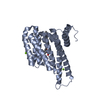 8alrC  8altC  8alvC 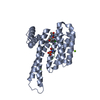 8alwC  8am7C  8anfC  8aoyC  8apsC  8aq1C  8aqcC  8aqeC  8aqzC  8ar4C  8ar5C  8argC  8aroC  8arqC  8arrC  8arwC  8arxC  8aryC  8arzC  8as1C  8at9C  8atrC  8atsC  8au2C  8ausC  8auyC  8av3C 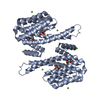 8av4C 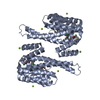 8av7C 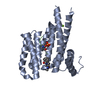 8av8C  8awgC  8axeC  8axuC  8azeC  8b39C 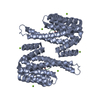 4jc3S S: Starting model for refinement C: citing same article ( |
|---|---|
| Similar structure data | Similarity search - Function & homology  F&H Search F&H Search |
- Links
Links
- Assembly
Assembly
| Deposited unit | 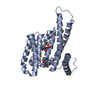
| ||||||||
|---|---|---|---|---|---|---|---|---|---|
| 1 | 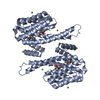
| ||||||||
| Unit cell |
| ||||||||
| Components on special symmetry positions |
|
- Components
Components
| #1: Protein | Mass: 26542.914 Da / Num. of mol.: 1 Source method: isolated from a genetically manipulated source Source: (gene. exp.)  Homo sapiens (human) / Gene: SFN, HME1 / Production host: Homo sapiens (human) / Gene: SFN, HME1 / Production host:  | ||||||||
|---|---|---|---|---|---|---|---|---|---|
| #2: Protein/peptide | Mass: 613.596 Da / Num. of mol.: 1 / Source method: obtained synthetically / Source: (synth.)  Homo sapiens (human) / References: UniProt: P03372 Homo sapiens (human) / References: UniProt: P03372 | ||||||||
| #3: Chemical | | #4: Chemical | ChemComp-O0O / | #5: Water | ChemComp-HOH / | Has ligand of interest | Y | Has protein modification | Y | |
-Experimental details
-Experiment
| Experiment | Method:  X-RAY DIFFRACTION / Number of used crystals: 1 X-RAY DIFFRACTION / Number of used crystals: 1 |
|---|
- Sample preparation
Sample preparation
| Crystal | Density Matthews: 2.66 Å3/Da / Density % sol: 53.72 % |
|---|---|
| Crystal grow | Temperature: 277 K / Method: vapor diffusion, sitting drop Details: 0.095 M HEPES (pH 7.1), 26% (v/v) PEG400, 0.19 CaCl2, 5% (v/v) Glycerol |
-Data collection
| Diffraction | Mean temperature: 100 K / Serial crystal experiment: N |
|---|---|
| Diffraction source | Source:  SYNCHROTRON / Site: SYNCHROTRON / Site:  PETRA III, DESY PETRA III, DESY  / Beamline: P11 / Wavelength: 1.0332 Å / Beamline: P11 / Wavelength: 1.0332 Å |
| Detector | Type: DECTRIS EIGER X 16M / Detector: PIXEL / Date: May 5, 2021 |
| Radiation | Protocol: SINGLE WAVELENGTH / Monochromatic (M) / Laue (L): M / Scattering type: x-ray |
| Radiation wavelength | Wavelength: 1.0332 Å / Relative weight: 1 |
| Reflection | Resolution: 1.4→45.53 Å / Num. obs: 56961 / % possible obs: 99.79 % / Redundancy: 13.4 % / CC1/2: 1 / Net I/σ(I): 34.1 |
| Reflection shell | Resolution: 1.4→1.452 Å / Num. unique obs: 5599 / CC1/2: 0.99 |
- Processing
Processing
| Software |
| ||||||||||||||||||||||||||||||||||||||||||||||||||||||||||||||||||||||||||||||||||||||||||||||||||||||||||||||
|---|---|---|---|---|---|---|---|---|---|---|---|---|---|---|---|---|---|---|---|---|---|---|---|---|---|---|---|---|---|---|---|---|---|---|---|---|---|---|---|---|---|---|---|---|---|---|---|---|---|---|---|---|---|---|---|---|---|---|---|---|---|---|---|---|---|---|---|---|---|---|---|---|---|---|---|---|---|---|---|---|---|---|---|---|---|---|---|---|---|---|---|---|---|---|---|---|---|---|---|---|---|---|---|---|---|---|---|---|---|---|---|
| Refinement | Method to determine structure:  MOLECULAR REPLACEMENT MOLECULAR REPLACEMENTStarting model: 4JC3 Resolution: 1.4→45.53 Å / Cor.coef. Fo:Fc: 0.972 / Cor.coef. Fo:Fc free: 0.962 / SU B: 1.208 / SU ML: 0.023 / Cross valid method: THROUGHOUT / ESU R: 0.048 / ESU R Free: 0.046 / Stereochemistry target values: MAXIMUM LIKELIHOOD Details: HYDROGENS HAVE BEEN ADDED IN THE RIDING POSITIONS U VALUES : REFINED INDIVIDUALLY
| ||||||||||||||||||||||||||||||||||||||||||||||||||||||||||||||||||||||||||||||||||||||||||||||||||||||||||||||
| Solvent computation | Ion probe radii: 0.7 Å / Shrinkage radii: 0.7 Å / VDW probe radii: 1.1 Å / Solvent model: MASK | ||||||||||||||||||||||||||||||||||||||||||||||||||||||||||||||||||||||||||||||||||||||||||||||||||||||||||||||
| Displacement parameters | Biso mean: 13.804 Å2
| ||||||||||||||||||||||||||||||||||||||||||||||||||||||||||||||||||||||||||||||||||||||||||||||||||||||||||||||
| Refinement step | Cycle: LAST / Resolution: 1.4→45.53 Å
| ||||||||||||||||||||||||||||||||||||||||||||||||||||||||||||||||||||||||||||||||||||||||||||||||||||||||||||||
| Refine LS restraints |
| ||||||||||||||||||||||||||||||||||||||||||||||||||||||||||||||||||||||||||||||||||||||||||||||||||||||||||||||
| LS refinement shell | Resolution: 1.401→1.438 Å / Total num. of bins used: 20
|
 Movie
Movie Controller
Controller



 PDBj
PDBj




















